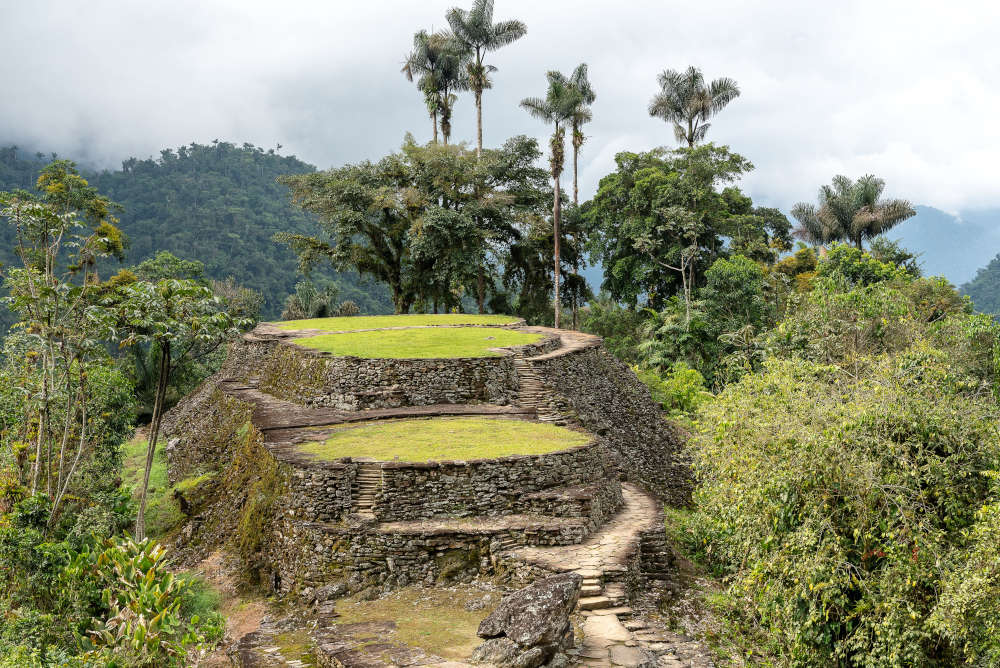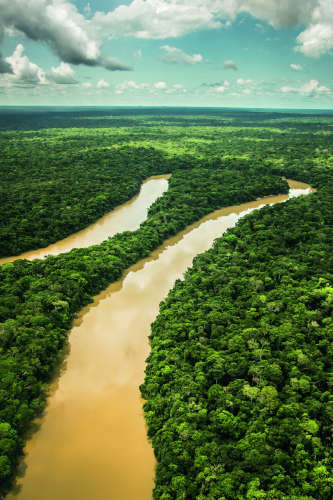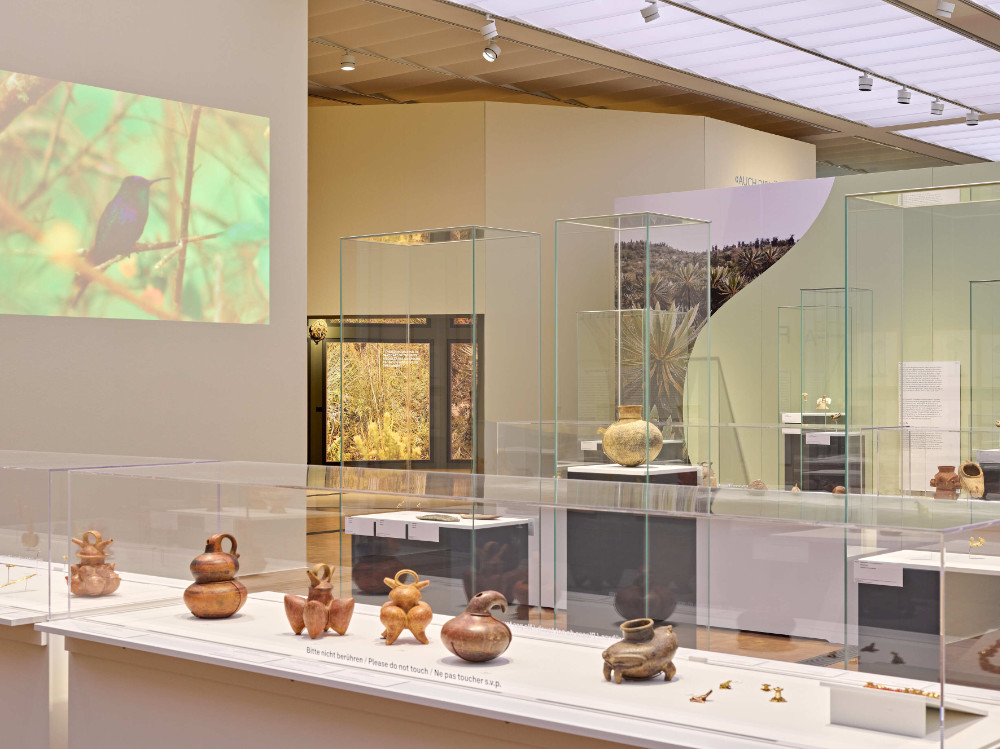More than Gold – Splendour and Thought in Indigenous Colombia
Pre-Hispanic Colombia has been associated with the legend of “El Dorado” in the Western world for centuries. Yet this view obscures the true cultural wealth of the indigenous peoples who live there. The groundbreaking exhibition “More Than Gold – Splendour and Thought in Indigenous Colombia” offers an entirely new perspective on the art and culture of this region. The exhibition is the first ever to explore the diverse spectrum of masterful artistic production in pre-Hispanic Colombia and spotlight these works from an indigenous perspective.
Content
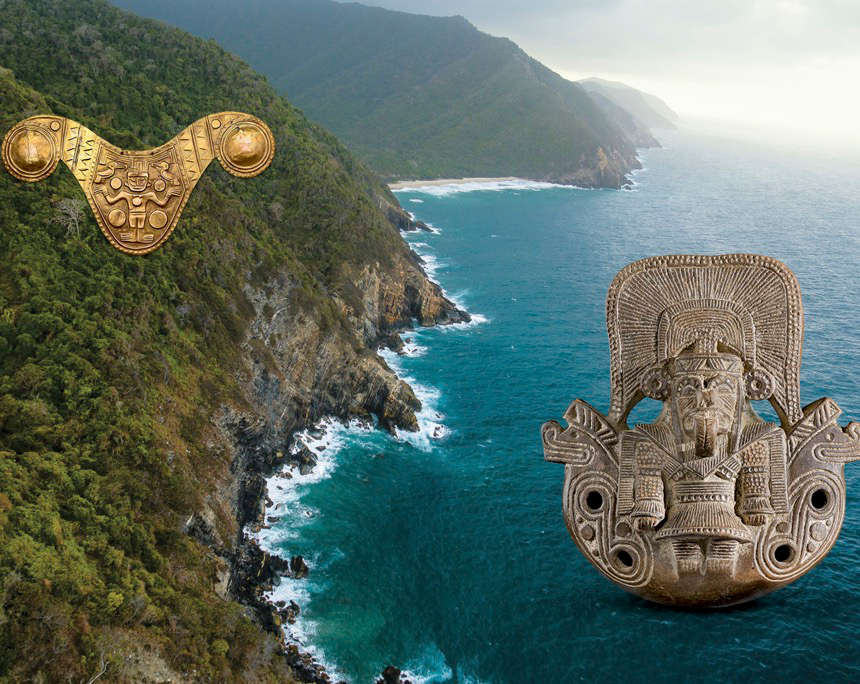
Breastplate with mythical creature, gold alloy, Colombia, Sierra Nevada de Santa Marta (Nahuange tradition), The Museum of Fine Arts, Houston, donated by Alfred C. Glassell, Jr. Ocarina in the form of a sitting chief with protruding tongue, ceramic, Colombia, Sierra Nevada de Santa Marta (Tairona tradition), Los Angeles County Museum of Art, The Muñoz Kramer Collection, donated by Camilla Chandler Frost and Stephen and Claudia Muñoz-Kramer Landscape photo: © Museum Associates/LACMA.
The exhibition was developed and organized in cooperation with the Los Angeles County Museum of Art (LACMA), the Museo del Oro in Bogotá, the Museum of Fine Arts in Houston and members of the Arhuaco indigenous community of Colombia. The Museum Rietberg in Zurich is the only museum in Europe to present the exhibition, now expanded to around 400 pieces, many of which have never been shown before in Switzerland. In addition to gold objects, the exhibition features ceramic vessels, stone sculptures and feather jewelry from Colombian, North American, German and Swiss collections.
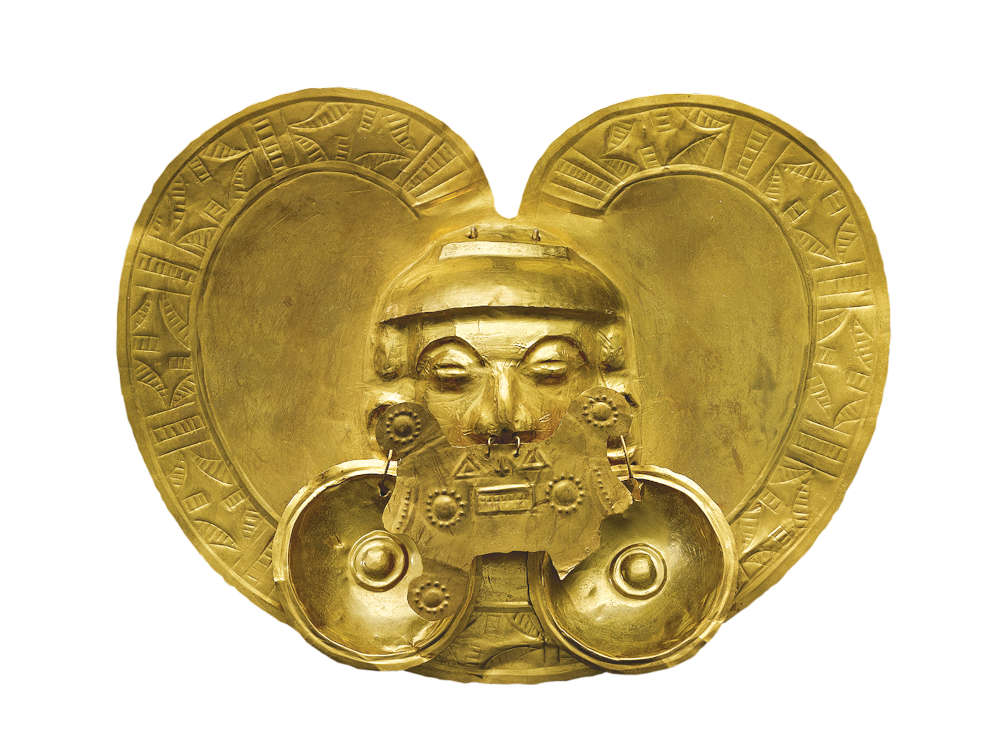
Breastplate with face, Colombia, Calima region, gold alloy, The Museum of Fine Arts, Houston, donated by Alfred C. Glassell, Jr.
New Curatorial Approach
Not only does the exhibition stand out for the outstanding artistic value of the featured works, but also for its innovative curatorial approach which offers fascinating insights into this largely unknown cultural circle. While earlier exhibitions have been distinguished by a mostly Western-oriented academic perspective, “More Than Gold” incorporates essential indigenous knowledge. Over a period of almost seven years, Julia Burtenshaw and Diana Magaloni (LACMA) worked closely with the Arhuaco to collect information about the objects and use it as the basis for the exhibition concept. Fernanda Ugalde, curator at Museum Rietberg, added several important aspects to the presentation in Zurich in coordination with the curators at LACMA, archaeologists at the Museo del Oro, partners of the Arhuaco community and Colombian artists.
Nature and the Cosmos
The Arhuaco live alongside three other indigenous groups in Sierra Nevada de Santa Marta on the Caribbean coast. They identify strongly with the Tairona who lived in this region long before the Spaniards arrived and who they consider their ancestors. As a result, the archaeological sites from that period, such as the pre-Hispanic city of Ciudad Perdida which was rediscovered in the 1970s, are not merely remnants of the past. For the Arhuaco, they are sacred and spiritual places which they continue to preserve and venerate to this day. They view the works of the Tairona in the same way, namely not as artworks of the past, but rather as living objects which carry within them fundamental values. These works often refer to cosmological beliefs, symbolic values and natural phenomena. The Arhuaco view them as records of human perspective and an understanding of the world that remains valid even today. The presence of one’s ancestors is a fundamental principle of indigenous society in Colombia. This deep-seated belief offers members a unique perspective on their own lives, the past and future, and their relationship to other beings. For example, the Arhuaco believe that every being possesses a soul – including trees, stones and vessels. They are all part of creation and consequently have no beginning and no end. The exhibition takes this into account by not specifying exact dates on the labels of the objects.
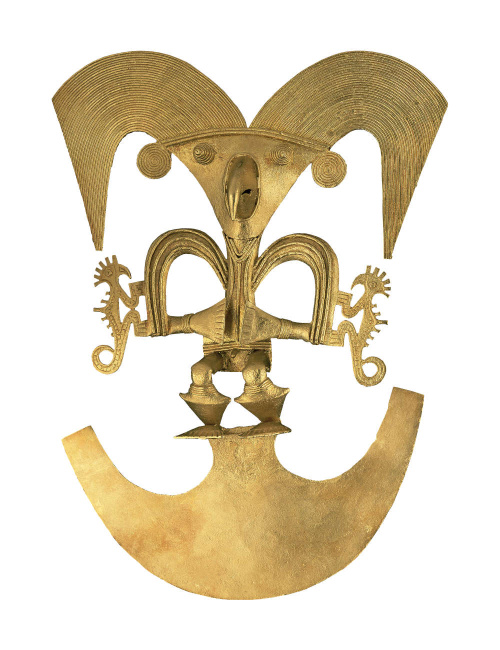
Breastplate depicting a birdman, Colombia, upper Cauca Valley, gold alloy, Museo del Oro – Banco de la República, Colombia, photo: © Clark M. Rodríguez.
Comprehensive Accompanying Program
The cooperation with the communities of Sierra Nevada de Santa Marta and Colombian cultural producers is not only limited to curatorial collaboration. In preparation for the exhibition in Zurich, Museum Rietberg teamed up with them to develop a multifaceted event program, including the play “Tungurahua” by Leonardo Abonía. The theatre dramaturge and researcher from Cali has studied the little-known area of pre-Hispanic theatre for many years. Visitors are also invited to join the Arhuaco in meditation exercises in the exhibition rooms and park and become better acquainted with their worldview. The musician and music ethnologist Juan Fernando Franco, who was involved in designing the exhibition concept, will present a musical work in concert. He plays various aeroponic instruments such as flutes, pipes and pre-Hispanic ocarinas, and in so doing, creates a connection to the acoustic world of his ancestors. The program also includes ocarina workshops for families.
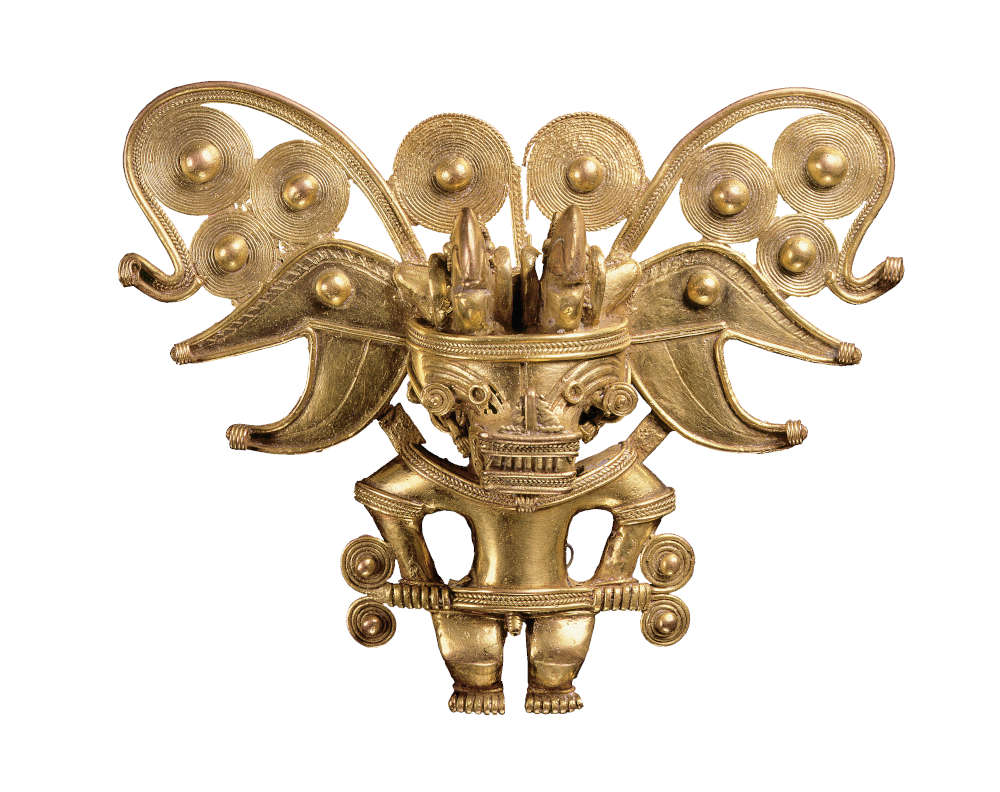
Pendant in the form of a batman with feathered headdress, Colombia, Sierra Nevada de Santa Marta, Museo del Oro – Banco de la República, Colombia, photo: © Clark M. Rodríguez.
The Legend of “El Dorado”
The country we call Colombia today is situated exactly at the center of continental North and South America. It connects the northern and southern hemispheres and stretches from the Atlantic to the Pacific Ocean. For centuries, it has cultivated relations with distant cultures through vast networks.
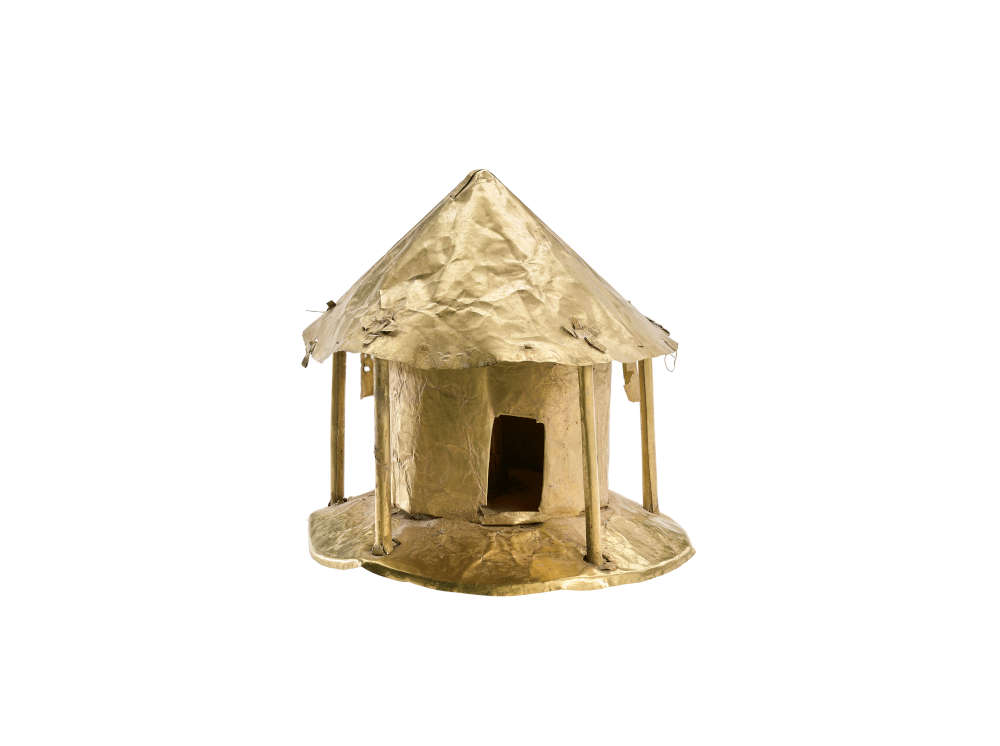
Model of a round house, Colombia, Calima region, Yotoco style, gold alloy, The Museum of Fine Arts, Houston, donated by Alfred C. Glassell, Jr.
For many people, the pre-Hispanic art of this region is forever tied to the legend of “El Dorado” – the mythical land of gold in the deep reaches of northern South America. In some of the first tales, “El Dorado” doesn’t even refer to a place, but rather a person. Indeed, there is evidence of ceremonies, in which a golden man played a role. For example, there is a description of a coronation ritual held for a cacique ruler of the Muisca in 1638. From a boat, he allegedly tossed a number of golden objects into Lake Guatavita as sacrificial offerings. The tale of a legendary treasure of gold not only roused the desires of the conquistadors of the 16th century, but also motivated numerous expeditions and raids, but none ended in success.
The fixation on gold objects as the embodiment of material affluence is rooted deeply in Western values. The material wealth and artistic forms of expression in Columbian culture does demonstrate, however, that gold was highly prized – and not only for its monetary value. Stone, ceramic and feather objects were just as likely to possess a comparable level of prestige. This is substantiated by 1,000-year-old petroglyphs, masterful stone sculptures, ceramic vessels, figurative statues and exquisitely crafted feather ornamentation.
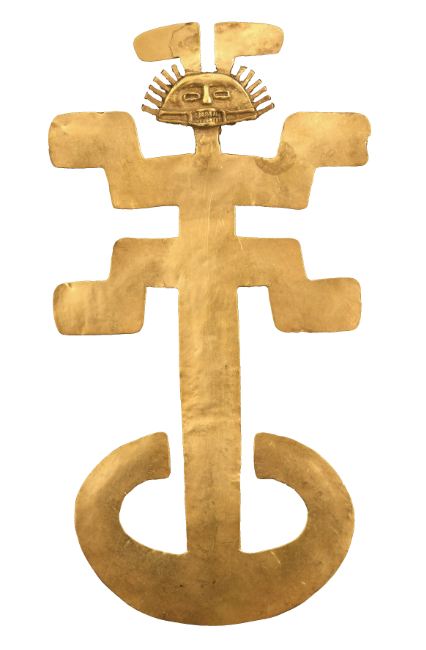
Breastplate with cat of prey, fish, bird and human elements, gold alloy, Colombia, upper to central Magdalena Valley (gold work in the Tolima style), Museo del Oro – Banco de la República, Colombia, photo: © Clark M. Rodríguez.
The Symbolic Power of Metals
Ancient Colombia is known for its highly developed metalworking techniques. Artisans in the north succeeded in perfecting the lost-wax casting method, while the southern cultures preferred hammering and working with sheet metal. The inhabitants along the Colombian and Ecuadorian Pacific coast were the only ones in the ancient world who mined and processed platinum.
The value of these items lies in their symbolic significance, and not according to the Western standards in the purity of the gold or their jewels. For example, most of the gold objects are made of “tumbaga”, an alloy consisting of copper and gold. This was produced on purpose as it exemplified the concepts of duality and complementarity which play a central role in the indigenous worldview. Copper and gold complement each other perfectly. Gold – yellow, shiny and unchanging – was traditionally equated with the sun and masculinity in indigenous Colombia. The reddish hue of copper, on the other hand, was associated with female characteristics. Its ability to tarnish and change color and texture shared similarity with the changing phases of the moon. “Tumbaga” thus represents the connection of the masculine and feminine, and the fertility which engenders new life.
Further Information
The More than Gold – Splendour and Thought in Indigenous Colombia can be see at the Museum Rietberg in Zurich from March 22 to July 21, 2024. A catalog has already been published. Information on the extensive accompanying program can be found online.






